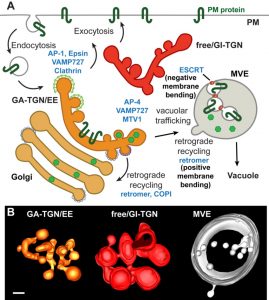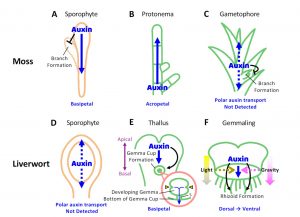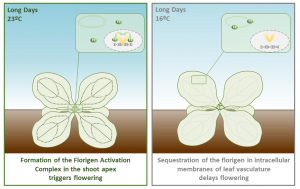Plant Science Research Weekly: September 24, 2021
Review: Fifteen compelling open questions in plant cell biology
 As part of The Plant Cell’s upcoming celebration of plant cell biology, Roeder et al. write about fifteen of the “open questions” in the field. This, and the other reviews that make up the focus issue, provide valuable insights into the leading edge of the discipline. Among the questions posed: How are the connections between cells (plasmodesmata) controlled and thus control the movements of molecules and signals between cells? How is polarity established within a single cell? (This question is addressed through looking at a classic model, the spores of horsetails, Equisetum). How do mechanical forces shape differentiation? How are the cellular pathways of cell wall synthesis, assembly, modification, and integrity sensing linked? And more. Share this with your students; any one of these open questions could provide an excellent starting point for a class discussion. (Summary by Mary Williams @PlantTeaching) Plant Cell 10.1093/plcell/koab225
As part of The Plant Cell’s upcoming celebration of plant cell biology, Roeder et al. write about fifteen of the “open questions” in the field. This, and the other reviews that make up the focus issue, provide valuable insights into the leading edge of the discipline. Among the questions posed: How are the connections between cells (plasmodesmata) controlled and thus control the movements of molecules and signals between cells? How is polarity established within a single cell? (This question is addressed through looking at a classic model, the spores of horsetails, Equisetum). How do mechanical forces shape differentiation? How are the cellular pathways of cell wall synthesis, assembly, modification, and integrity sensing linked? And more. Share this with your students; any one of these open questions could provide an excellent starting point for a class discussion. (Summary by Mary Williams @PlantTeaching) Plant Cell 10.1093/plcell/koab225
Review: Bryophytes as model systems for studying evolutionary cell and developmental biology
 The development of Arabidopsis as a model system greatly advanced the field of plant cell biology by bringing in molecular approaches, so much of our conceptual foundation rests on studies from angiosperms. More recently, model bryophytes, particularly Marchantia polymorpha (liverworts) and Physcomitrium patens (mosses) have provided additional insights, as discussed in this review by Naramoto et al. The authors focus on polarized elongation, symmetric and asymmetric cell division and polar auxin transport. The direct comparison of these important processes between bryophytes and angiosperms, particularly in regards to their roles in establishing multicellular plant bodies, provides deep insights into the biology of plant cells. (Summary by Mary Williams @PlantTeaching) Plant Cell 10.1093/plcell/koab218
The development of Arabidopsis as a model system greatly advanced the field of plant cell biology by bringing in molecular approaches, so much of our conceptual foundation rests on studies from angiosperms. More recently, model bryophytes, particularly Marchantia polymorpha (liverworts) and Physcomitrium patens (mosses) have provided additional insights, as discussed in this review by Naramoto et al. The authors focus on polarized elongation, symmetric and asymmetric cell division and polar auxin transport. The direct comparison of these important processes between bryophytes and angiosperms, particularly in regards to their roles in establishing multicellular plant bodies, provides deep insights into the biology of plant cells. (Summary by Mary Williams @PlantTeaching) Plant Cell 10.1093/plcell/koab218
Opinion: Seeds as natural capital ($)
 Plants are increasingly being recognized for their contributions to human wellbeing. However, most attention has been given to services provided by adult plants or those derived from their interaction with pollinators. In this exciting piece, Mattana and colleagues advocate for the importance of seeds and describe their natural capital value using a total economic value approach. Under this framework, seeds have value for their existence and their current and potential uses, whether material or intangible or direct or indirect. On the one hand, seeds shape the regeneration of a vast majority of plants, which impacts ecosystem resilience. Therefore, their existence is crucial for ecosystem functioning and adaptation to climate change. On the other hand, seeds have a myriad of uses: from cereals and pulses that feed millions of people worldwide to key elements of the cultural identity of communities. Moreover, they might host other uses and properties yet to be discovered. Therefore, this work highlights the relevance of seeds on the formulation of nature-based solutions to reverse the current degradation of our planet and achieve the Sustainable Development Goals proposed by the United Nations. (Summary by Carlos A. Ordóñez-Parra @caordonezparra) Trends Plant Sci. 10.1016/j.tplants.2021.08.008
Plants are increasingly being recognized for their contributions to human wellbeing. However, most attention has been given to services provided by adult plants or those derived from their interaction with pollinators. In this exciting piece, Mattana and colleagues advocate for the importance of seeds and describe their natural capital value using a total economic value approach. Under this framework, seeds have value for their existence and their current and potential uses, whether material or intangible or direct or indirect. On the one hand, seeds shape the regeneration of a vast majority of plants, which impacts ecosystem resilience. Therefore, their existence is crucial for ecosystem functioning and adaptation to climate change. On the other hand, seeds have a myriad of uses: from cereals and pulses that feed millions of people worldwide to key elements of the cultural identity of communities. Moreover, they might host other uses and properties yet to be discovered. Therefore, this work highlights the relevance of seeds on the formulation of nature-based solutions to reverse the current degradation of our planet and achieve the Sustainable Development Goals proposed by the United Nations. (Summary by Carlos A. Ordóñez-Parra @caordonezparra) Trends Plant Sci. 10.1016/j.tplants.2021.08.008
Florigen sequestration in cellular membranes modulates temperature-responsive flowering
 The existence of the FLORIGEN – a mobile floral activator produced in the leaf and transported to the apex – was hypothesized almost a century ago but its molecular nature remained elusive for decades. In the last 15 years, independent groups demonstrated that members of the Phosphatidyl Ethanolamine-Binding Proteins (PEBP) family act as florigen in several plant species. Although PEBPs are not able to directly bind DNA, they interact with regulatory proteins to form the Florigen Activation Complex, which controls the expression of genes involved in flower development in the shoot apical meristem. Here, Susila and coworkers investigated the ability of the Arabidopsis florigen, FLOWERING LOCUS T (FT), to bind lipids in vitro and in vivo. They found that FT preferentially interacts with phosphatidylglycerol (PG, negatively charged phospholipids) and localizes to some intracellular membranes (e.g. chloroplast) in addition to the nucleus. The authors also discovered that mutants impaired in PG biosynthesis flowered earlier than wildtypes under inductive long days at 16ºC, likely due to increased accumulation of FT in the soluble fraction. Additional experiments indicated that PG sequestered FT in chloroplasts and trans-Golgi, thus delaying the floral transition in response to lower temperature. This study provides an additional layer of complexity to the regulation of the florigen: while most of the components of the photoperiod pathway control the expression of FT in the leaf vasculature, PG control the transport of FT from leaf companion cells to sieve elements. These mechanisms allow fine tuning of flowering time in response to not only daylength but also temperature seasonal changes. (Summary and image by Michela Osnato @michela_osnato). Science 10.1126/science.abh4054
The existence of the FLORIGEN – a mobile floral activator produced in the leaf and transported to the apex – was hypothesized almost a century ago but its molecular nature remained elusive for decades. In the last 15 years, independent groups demonstrated that members of the Phosphatidyl Ethanolamine-Binding Proteins (PEBP) family act as florigen in several plant species. Although PEBPs are not able to directly bind DNA, they interact with regulatory proteins to form the Florigen Activation Complex, which controls the expression of genes involved in flower development in the shoot apical meristem. Here, Susila and coworkers investigated the ability of the Arabidopsis florigen, FLOWERING LOCUS T (FT), to bind lipids in vitro and in vivo. They found that FT preferentially interacts with phosphatidylglycerol (PG, negatively charged phospholipids) and localizes to some intracellular membranes (e.g. chloroplast) in addition to the nucleus. The authors also discovered that mutants impaired in PG biosynthesis flowered earlier than wildtypes under inductive long days at 16ºC, likely due to increased accumulation of FT in the soluble fraction. Additional experiments indicated that PG sequestered FT in chloroplasts and trans-Golgi, thus delaying the floral transition in response to lower temperature. This study provides an additional layer of complexity to the regulation of the florigen: while most of the components of the photoperiod pathway control the expression of FT in the leaf vasculature, PG control the transport of FT from leaf companion cells to sieve elements. These mechanisms allow fine tuning of flowering time in response to not only daylength but also temperature seasonal changes. (Summary and image by Michela Osnato @michela_osnato). Science 10.1126/science.abh4054



